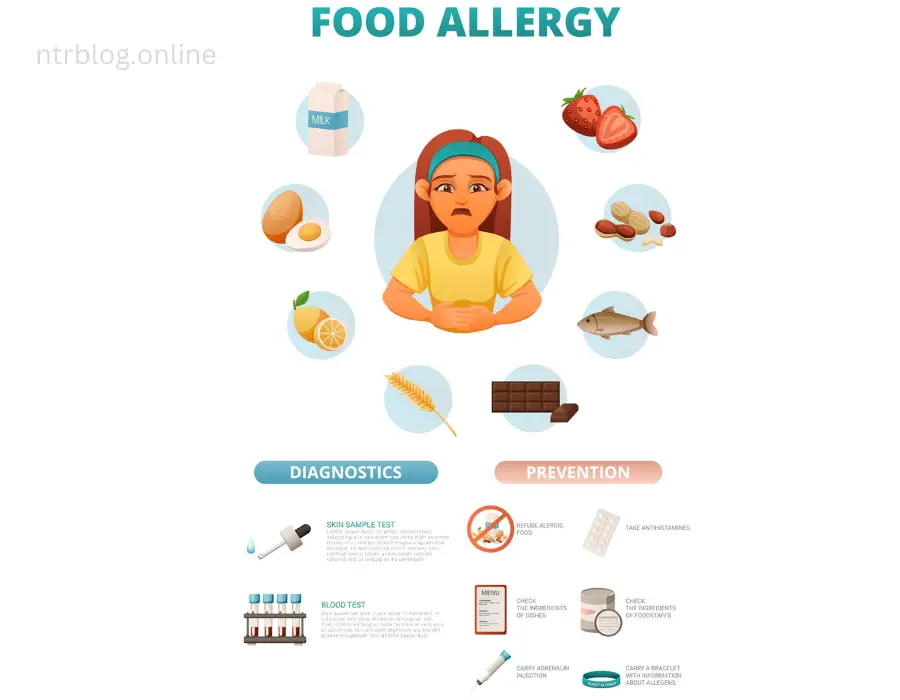Overview:
Understanding the difference between a food intolerance and a food allergy:
While the onset of symptoms after consuming certain foods may lead one to assume a food allergy, the reality may lean toward food intolerance, which affects about 20% of the U.S. It is important to distinguish between these two conditions to clearly understand how specific foods interact with the body.
Table of Contents
Difference between food intolerance and food allergy :
Registered dietitian Sharon Jaeger, RD, underlines the difference between food intolerances and food allergies, emphasizing their effects on the body in specific ways. Food intolerances generally trigger unpleasant symptoms, mainly centered around gastrointestinal discomfort. These symptoms, although distressing, rarely pose an immediate life-threatening risk. In contrast, food allergies trigger more pronounced, sometimes severe reactions, which can quickly escalate to life-threatening conditions.
Understanding the nuances of these conditions enables individuals to better understand their body’s response to certain foods. While food intolerances can trigger distressing symptoms like an upset stomach or diarrhea, food allergies tend to trigger a spectrum of more serious and potentially life-threatening manifestations, emphasizing the need for precision in identification and management.
Understanding the causes and symptoms:
Sharon Jaeger, RD, delves into the differences between food allergies, food intolerances and food sensitivities, emphasizing their respective effects on the body
Food allergies:
In the case of food allergies, Jaeger explained that the immune system perceives specific proteins or ingredients in food as potential threats, triggering an immune response Notably, eight types of foods contribute to about 90% of all food allergies, including eggs, fish, milk, peanuts, shellfish , soy, tree nuts (cashews, walnuts, etc.), and wheat are common culprits
Food allergies are characterized by a rapid onset of symptoms, usually 30 minutes to two hours after ingestion of the offending food This immediate immune response can prove fatal without prompt treatment, often requiring injections of epinephrine or adrenaline. Anaphylaxis and other severe allergic reactions can manifest with symptoms such as rash, difficulty swallowing, swelling of the lips, tongue, throat, difficulty breathing or trouble breathing.
Food intolerance:
Conversely, food intolerances develop when the body struggles to adequately break down certain foods or their components. Jaeger highlights lactose intolerance as an example, where an enzyme deficiency prevents proper breakdown of lactose, the sugar found in dairy products Unlike allergies, symptoms of food intolerance, though uncomfortable, are not life-threatening and primarily include gastrointestinal distress, such as diarrhea, gas, bloating, heartburn, nausea; Abdominal pain, and a general upset stomach, usually appear several hours after consumption of humiliating food.
Food sensitivities:
Jaeger distinguishes food sensitivities as immune responses, though slower than allergies, often caused by imbalances within the gastrointestinal tract These sensitivities have symptoms reminiscent of mild allergic reactions, such as brain fog, fatigue, reddish skin, itching, joint or muscle aches, headaches or migraines, sneezing, runny nose Va Interestingly, the onset of symptoms can be delayed, occurring up to three days after ingestion of the trigger meal. Jaeger attributes this delayed response to an imbalance in gut bacteria, making it challenging to correlate symptoms with specific foods.
Celiac Disease: Allergy or Intolerance?
Sharon Jaeger, R.D., explains that while celiac disease exhibits similar symptoms, it is different from food allergies and intolerances Celiac disease represents an autoimmune disorder triggered by a protein commonly found in grains such as gluten, wheat, barley, and rye. For individuals with celiac disease, even minute traces of gluten intake can damage the small intestine, causing severe reactions within the gastrointestinal tract
However, this distinction is evident in cases of gluten intolerance where a person may experience discomfort such as bloating, gas, or fatigue after eating gluten-containing foods. However, unlike celiac disease, gluten intolerance does not cause an allergic reaction or impairment of the gastrointestinal tract.
Are food allergies and intolerances genetic?
While further investigation is needed, existing studies suggest a strong genetic predisposition to food allergies, especially in children of parents with these conditions who conversely have either a genetic basis for food intolerance and sensitivity or can develop gradually over time, often influenced by various environmental factors.
When do food allergies occur?
Food allergies usually manifest in childhood, especially with regard to foods such as milk, eggs, nuts and soy. However, there are instances where these allergies can surface later in life, suggesting that their onset is not always predictable. Early introduction of potentially allergenic foods, as supported by research, may help prevent peanut allergy in high-risk infants, emphasizing the importance of consulting allergists for guidance in such cases
Furthermore, intolerance and sensitivity may emerge or intensify with age. For example, lactose intolerance is often more noticeable as individuals age due to decreased production of the enzyme responsible for lactose digestion in dairy products, which explains how these conditions can develop over time.
How to find out if you have a food intolerance or allergy :
Seeking guidance from a healthcare professional is critical to determining if you are dealing with a food allergy intolerance. Sharon Jaeger, RD, highlights the importance of consulting a health care provider to establish an appropriate management plan and reduce symptoms that affect one’s daily life.

Diagnostic approach:
1. Allergy Testing:
– Allergy skin tests and blood tests serve as key tools to identify allergic reactions or high levels of allergic antibodies within the body. However, pinpointing the exact cause of food intolerance or sensitivity remains challenging. There is a lack of proven skin blood tests for these conditions other than the hydrogen breath test specifically designed to diagnose lactose intolerance Jaeger stresses that while these tests provide insight, they do not provide a comprehensive understanding and are not definitive.
2. Keep a food diary:
– Maintaining a detailed food diary proves invaluable in documenting your food intake alongside symptoms experienced. This careful record enables individuals to identify patterns between consumed foods and subsequent discomfort. Persistent recurrence of symptoms after consumption of a specific food indicates the possibility of intolerance.
3. Try an elimination diet:
– Starting an elimination diet in collaboration with a healthcare provider can help pinpoint the source of discomfort. In this approach, systematic removal of suspected trigger foods from the diet followed by reintroduction to observe symptom recurrence The presence or absence of symptoms on readmission is a key aspect in identifying food intolerance.
Jaeger emphasizes the importance of carefully monitoring food intake, symptom manifestations and patterns over time, which contributes significantly to gathering necessary information to aid in diagnosis.
How to manage your body’s reactions to food:
Navigating the complexities of identifying and minimizing adverse food reactions can be challenging. However, once the triggers behind your symptoms are determined, it is important to employ effective strategies in preventing and managing these reactions.
Prevention and management strategies:
1. Cut out the offending foods:
– “Avoidance serves as the primary and most effective method in the management of allergies and intolerances,” emphasizes Jaeger. Keeping away from foods or ingredients that trigger adverse reactions remains a cornerstone in preventing a flare-up of symptoms. Identifying and eliminating these culprits from your diet is essential for symptom control.
2. Over-the-Counter Drugs:
– Pharmacist medications can provide relief in certain cases of food intolerance. In particular, individuals with lactose intolerance will benefit from products such as Lactaid®. These medications allow you to consume dairy products appropriately without negative side effects, helping to manage symptoms while enjoying certain foods
3. Carry epinephrine auto-injector:
– Jaeger strongly advises individuals aware of allergic reactions to specific foods to carry an epinephrine auto-injector such as the AUVI-Q® or EpiPen® at all times. It’s equally important to ensure that both yourself and those close to you are strong in using it. This precautionary measure remains critical in promptly addressing severe allergic reactions while providing potentially life-saving intervention in an emergency
These proactive measures—avoiding triggers, using appropriate medications, and having emergency interventions accessible—are integral to effectively managing and reducing the impact of food-related allergies and intolerances on daily life.
conclusion:
Understanding and effectively managing food allergies and intolerances remains a fundamental pillar to alleviate symptoms and improve overall health through diligently identifying triggers, implementing strategic preventive measures, using medications where appropriate, and preparing with emergency interventions like epinephrine auto-injectors The effect Navigates and reduces This proactive approach empowers individuals to take charge of their health and proactively reduce the challenges posed by food-related allergies and intolerances

FAQs.
Q. What’s the difference between a food intolerance and a food allergy ?
A. – Food allergies: Triggers an immune system response to specific food proteins, potentially resulting in serious, life-threatening reactions.
– Food intolerances: There are difficulties in digesting certain foods, mainly manifesting as milder, mainly digestive symptoms without engaging the immune system response.
Q. How can their body’s food response be effectively managed?
A. Managing the body’s reactions to food involves a series of important steps:
1. Identify Triggers: Find out the specific foods or ingredients causing the reaction through careful record-keeping or seeking expert advice.
2. Implement avoidance: Once identified, refrain from consuming trigger foods to prevent adverse reactions.
3. Pharmaceutical options: In some cases, the use of pharmacists such as lactase supplements to reduce symptoms, allowing occasional consumption of specific foods.
4. Emergency preparedness: Carry an epinephrine auto-injector for severe allergies, understand its use, and ensure close contacts are familiar with its administration.
5. Seeking Professional Guidance: Consultation with healthcare providers for accurate diagnosis, personalized management plans, and expert advice on elimination diets.
6. Lifestyle adjustments: Adapting daily routines to accommodate avoiding trigger foods and effectively reducing reactions.
7. Continuous monitoring: Monitoring for symptoms, dietary modifications, and their effects to comprehensively manage and interpret the body’s responses to food, aids in informed decision-making and proactive management strategies.


